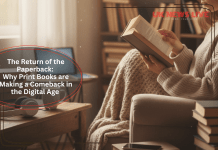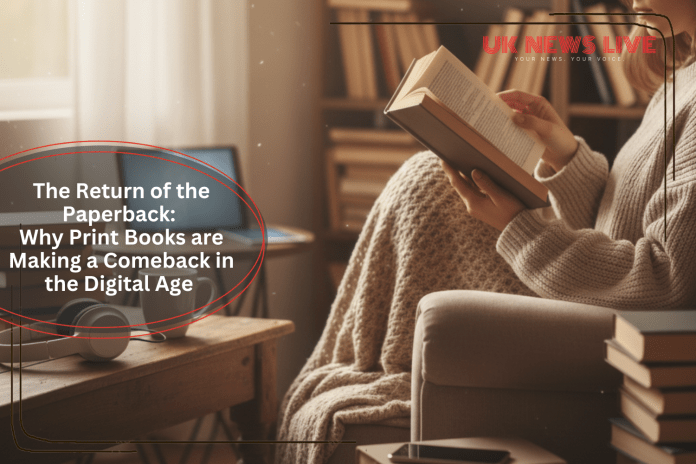For years, it looked as though the printed book might become a quaint relic — a nostalgic object left behind by the speed and convenience of digital life. Kindles, tablets and audiobooks promised an endless library in our pockets. Yet, in a surprising cultural twist, the humble paperback is making a remarkable comeback.
According to the Publishers Association’s Publishing in 2023 report, total revenue for the UK publishing industry reached a record £7.1 billion, marking a 3% increase on 2022 and the highest level ever recorded for the sector.
Print continues to dominate the consumer market, accounting for 79% of publishing revenue, despite rapid digital growth. Within the consumer market — which generated £2.4 billion overall, up 4% year-on-year — print book revenue alone reached £1.9 billion, a 2% rise driven largely by the continued popularity of both fiction and non-fiction titles.
The industry’s broader impact remains substantial: publishing contributes more than £11 billion to the UK economy annually and exports more books than any other country in the world — a cultural and economic success story that continues to defy expectations in the age of streaming and scrolling.
Recent retail data further supports the print resurgence. Bookseller Waterstones reported a 5% rise in revenue in 2025, with fiction sales up 12.2% year-on-year, attributing much of the increase to the enthusiasm of younger readers — particularly Gen Z. Despite the rise of e-readers and digital downloads, print still represents around 80% of total book sales in the UK market, according to Waterstones’ figures.
While digital formats such as e-books and audiobooks have grown steadily, it is increasingly clear that print maintains its emotional and experiential edge. Readers, it seems, still value the feel of a book in their hands and the permanence of words on paper.
A tactile Escape in a Digital World
The resurgence of the paperback is, in many ways, a reaction to our hyper-digital existence. After years of screen fatigue, from remote work to constant scrolling, readers are rediscovering the satisfaction of turning real pages. A physical book offers something screens can’t: texture, permanence, and focus.
Reading specialists and psychologists studying attention and reading behaviour argue that paperbacks offer something digital media cannot: texture, focus, and a sense of permanence, largely because reading on paper encourages immersion and memory retention by reducing cognitive distractions.
In an era where much of life is ephemeral, the paperback represents endurance. A shelf of books is a visual record of ideas absorbed, and journeys taken — something that can’t be replicated by a digital reading list.
The Influence of Social Trends 
Part of the paperback’s revival has been fuelled by online culture itself. TikTok’s “BookTok” community, which now drives significant book sales, has turned reading into a social phenomenon. The more beautifully designed the cover, the more shareable it becomes. Ironically, social media — once blamed for diminishing attention spans — is now inspiring millions to pick up printed novels again.
There’s also an aesthetic and emotional component. Books have become lifestyle objects: something to display, collect, and gift. The rise of minimalist interiors and “quiet luxury” design trends have only reinforced the appeal of carefully chosen, tactile items over disposable digital media.
Independent Publishing and the Democratisation of Print
Another driving force behind the paperback revival is the growth of independent and self-publishing. Once limited to those with publishing contracts, print production is now accessible to anyone with a manuscript and a vision. Print-on-demand technology allows authors to produce professional-quality paperbacks in small batches, without the need for huge upfront print runs.
Platforms such as Doxzoo, a UK-based online printing service, have become part of this new printing revolution. Their technology enables writers, artists, educators and businesses to print paperback books in both small-batch and bulk runs quickly and affordably.
As Paul Bennett, General Manager at Doxzoo, explains:
“We’ve seen a noticeable rise in individuals and small publishers ordering paperback books — not only for novels and memoirs, but for creative projects, corporate publications and community initiatives. There’s a renewed appreciation for holding a finished work in your hands. It’s tangible proof that an idea has taken form.”
This accessibility has opened the door for countless new voices. Indie authors can now release paperbacks alongside e-books, offering readers the choice between digital convenience and physical connection. Small businesses, too, are producing printed guides, training manuals and commemorative books to add a human touch to their brands.
The Psychology of the Page 
Research continues to underline the cognitive advantages of reading from paper over screens. A new scientific study led by the University of Valencia examined the reading habits of more than 470,000 students and found that reading printed books significantly improves comprehension and learning outcomes compared with digital reading.
The researchers concluded that printed materials could enhance understanding by as much as six times compared with screens, particularly among primary and middle school pupils. They suggest that the design of digital devices — intended for multitasking and entertainment — naturally invites distraction, while printed pages encourage deeper focus and absorption.
According to the study, children who spend around ten hours reading printed books may gain up to six to eight times more comprehension than those who spend the same amount of time reading from tablets or smartphones. The findings reinforce what many parents, educators and readers have long suspected: that reading on paper promotes stronger concentration and lasting engagement than reading on a screen.
Moreover, print reading tends to promote mindfulness. The absence of hyperlinks, notifications or infinite feeds allows readers to sink into a single narrative. For many, that sense of focus has become a rare luxury.
Sustainability and slow Consumption
The renewed enthusiasm for print also ties into a broader shift towards sustainability and “slow consumption”. Consumers are increasingly favouring quality over quantity — buying fewer books, but ones that they truly value and will keep. Modern printing services have adapted by offering eco-friendly paper options and efficient production methods that minimise waste.
This new model of printing — agile, on-demand, and environmentally conscious — allows paperbacks to flourish without the environmental costs once associated with traditional mass printing. For readers, it means being able to enjoy physical books with a cleaner conscience.
A cultural Counterbalance
Ultimately, the return of the paperback isn’t just about nostalgia; it’s about balance. As digital life becomes ever more dominant, physical media provide an anchor. We still want the immediacy of the cloud, but we also crave the authenticity of the tangible.
Owning a printed book has become a quiet act of resistance — a way to reclaim time and attention in a distracted age. Whether it’s a well-worn classic, a self-published collection of poetry, or a bespoke paperback printed via a service like Doxzoo, the physicality of the object matters.
The paperback’s resilience is a reminder that progress doesn’t always mean replacement. Sometimes, it means rediscovery.
And perhaps that’s what makes the paperback so powerful in 2025: not that it’s new, but that it feels, once again, necessary.






























